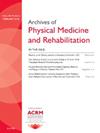Test–Retest Reliability and Responsiveness of the Machine Learning-Based Short-Form of the Berg Balance Scale in Persons With Stroke
IF 3.6
2区 医学
Q1 REHABILITATION
Archives of physical medicine and rehabilitation
Pub Date : 2025-06-01
DOI:10.1016/j.apmr.2024.10.013
引用次数: 0
Abstract
Objective
To examine the test–retest reliability, responsiveness, and clinical utility of the machine learning-based short form of the Berg Balance Scale (BBS-ML) in persons with stroke.
Design
Repeated-measures design.
Setting
A department of rehabilitation in a medical center.
Participants
This study recruited 2 groups: 50 persons who were more than 6 months post-stroke to examine the test–retest reliability, and 52 persons who were within 3 months post-stroke to examine the responsiveness. Test–retest reliability was investigated by administering assessments twice at a 2-week interval. Responsiveness was investigated by gathering data at admission and discharge from the hospital.
Interventions
Not applicable.
Main Outcome Measure
BBS-ML.
Results
The BBS-ML exhibited excellent test–retest reliability (intraclass correlation coefficient=0.99), acceptable minimal random measurement error (minimal detectable change %=13.6%), and good responsiveness (Kazis’ effect size and standardized response mean values≥1.34). On average, the participants completed the BBS-ML in around 6 minutes per administration.
Conclusions
Our findings indicate that the BBS-ML appears an efficient measure with excellent test–retest reliability and responsiveness. Moreover, the BBS-ML may be used as a substitute for the original BBS to monitor the progress of balance function in persons with stroke.
基于机器学习的短式伯格平衡量表在脑卒中患者中的重测信度和响应度
目的研究基于机器学习的短式伯格平衡量表(BBS-ML)在脑卒中患者中的重测可靠性、响应性和临床实用性:设计:重复测量设计:环境:一家医疗中心的康复科:本研究招募了两组人员:50 名脑卒中后超过 6 个月的患者,以考察测验重测可靠性;52 名脑卒中后 3 个月内的患者,以考察反应性。通过每两周进行两次评估来考察重测可靠性。干预措施:不适用:主要结果测量:BBS-ML:BBS-ML显示出极佳的重测可靠性(类内相关系数=0.99)、可接受的最小随机测量误差(最小可检测变化%=13.6%)和良好的反应性(卡齐斯效应大小和标准化反应平均值≥1.34)。平均而言,受试者每次完成 BBS-ML 的时间约为 6 分钟:我们的研究结果表明,BBS-ML 是一种高效的测量方法,具有良好的测试-再测试可靠性和响应性。此外,BBS-ML 还可以替代原有的 BBS,用于监测脑卒中患者平衡功能的进展情况。
本文章由计算机程序翻译,如有差异,请以英文原文为准。
求助全文
约1分钟内获得全文
求助全文
来源期刊
CiteScore
6.20
自引率
4.70%
发文量
495
审稿时长
38 days
期刊介绍:
The Archives of Physical Medicine and Rehabilitation publishes original, peer-reviewed research and clinical reports on important trends and developments in physical medicine and rehabilitation and related fields. This international journal brings researchers and clinicians authoritative information on the therapeutic utilization of physical, behavioral and pharmaceutical agents in providing comprehensive care for individuals with chronic illness and disabilities.
Archives began publication in 1920, publishes monthly, and is the official journal of the American Congress of Rehabilitation Medicine. Its papers are cited more often than any other rehabilitation journal.

 求助内容:
求助内容: 应助结果提醒方式:
应助结果提醒方式:


